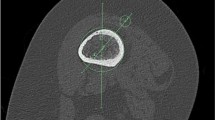Abstract
Computed tomography was used to analyze the patellofemoral relationship during the first 60° of knee flexion in patients with chronic patellofemoral pain syndrome (49 knees) and a healthy control group (15 knees). The patellofemoral joints were imaged axially through the center of the patella articular cartilage with the knee flexed 0°, 0° with maximal quadriceps muscle contraction, 30°, and 60°. In 0° of knee flexion, the sulcus angle was greater in the symptomatic group than in normal controls. The patella displaced further laterally, and the lateral patellar tilt was greater. The patellar lateral index was found to be greater at 0° and indicated severe abnormality with full quadriceps muscle contraction. The Laurin angle was pathologic with increased medial opening, especially with muscle contraction. At 30° of knee flexion, these differences were less marked than at 0°. No relevant differences were found with 60° of knee flexion. This study showed that the sulcus angle, lateral patellar displacement, lateral patellar tilt, patella lateral condyle index, and Laurin angle are relevant diagnostic features in 0° of knee flexion, indicating a pathological femoral patellar gliding mechanism. Our evaluation also demonstrated the influence of full quadriceps muscle contraction, especially regarding lateral patellar displacement and the Laurin angle, and it was most prominent on the patella lateral condyle index. Thus, quadriceps muscle contraction often creates a more pathological displacement of the patella, which can be depicted using axial computed tomography.
Similar content being viewed by others
References
Biedert RM, Friederich NF (1994) Failed lateral retinacular release: clinical outcome. J Sports Traumatol 16:162–173
Delgado-Martins H (1979) A study of the position of the patella using computerised tomography. J Bone Joint Surg [Br] 61:443–444
Goodfellow JW, Hungerford DS, Woods C (1976) Patellofemoral joint mechanics and pathology. 2. Chondromalacia patellae. J Bone Joint Surg [Br] 58:291–299
Hille E, Schulitz KP, Henrichs C, Schneider T (1985) Pressure and contact-surface measurements within the femoropatellar joint and their variations following lateral release. Arch Orthop Trauma Surg 104:275–282
Hughston JC, Deese M (1988) Medial subluxation of the patella as a complication of lateral release. Am J Sports Med 16:383–388
Insall J, Salvati E (1977) Patella position in the normal knee. Joint Radiol 101:101
Kujala UM, Österman K, Kormano M, Komu M, Schlenzka D (1989) Patellar motion analyzed by magnetic resonance imaging. Acta Orthop Scand 60:13–16
Kujala UM, Kormano M, Österman K, Nelimarkka O, Hurme M, Taimela S, Dean PB (1992) Magnetic resonance imaging analysis of patellofemoral congruity in females. Clin J Sports Med 2:21–26
Larson RL, Cabaud HE, Slocum DB, James SL, Keenan T, Hutchinson T (1982) The patellar compression syndrome: surgical treatment by lateral retinacular release. Clin Orthop 134:158–167
Laurin CA, Levesque HP, Dussault R, Labelle H, Peides JP (1979) The abnormal lateral patello-femoral angle; a diagnostic roentgenographic sign of recurrent subluxation. J Bone Joint Surg [Am] 60:55–60
Martinez S, Korobkin M, Fondren FB, Hedlund LW, Goldner JL (1983) Diagnosis of patellofemoral malalignment by computed tomography. J Compt Assist Tomogr 7:1050–1053
Metcalf RW (1982) Arthroscopic method for lateral release of the subluxing and dislocating patella. Clin Orthop 167:9–18
Pinar H, Akseki D, Karaoglan O, Geng J (1994) Kinematic and dynamic axial computed tomography of the patello-femoral joint in patients with anterior knee pain. Knee Surg Sports Traumatol Arthroscopy 2:170–173
Sasaki T, Yagi T (1986) Subluxation of the patella: investigation by computerized tomography. Int Orthop 10:115–120
Schutzer SF, Ramsby GR, Fulkerson JP (1986) Computed tomographic classification of patellofemoral pain patients. Orthop Clin North Am 17:235–248
Author information
Authors and Affiliations
Rights and permissions
About this article
Cite this article
Biedert, R.M., Gruhl, C. Axial computed tomography of the patellofemoral joint with and without quadriceps contraction. Arch Orthop Trauma Surg 116, 77–82 (1997). https://doi.org/10.1007/BF00434106
Received:
Issue Date:
DOI: https://doi.org/10.1007/BF00434106




